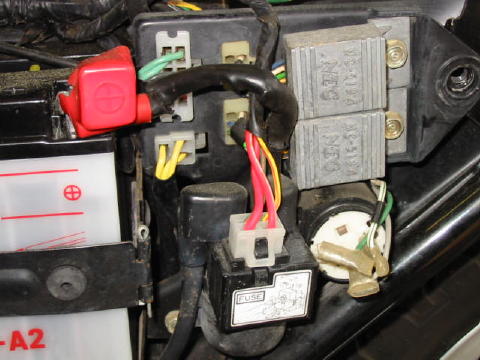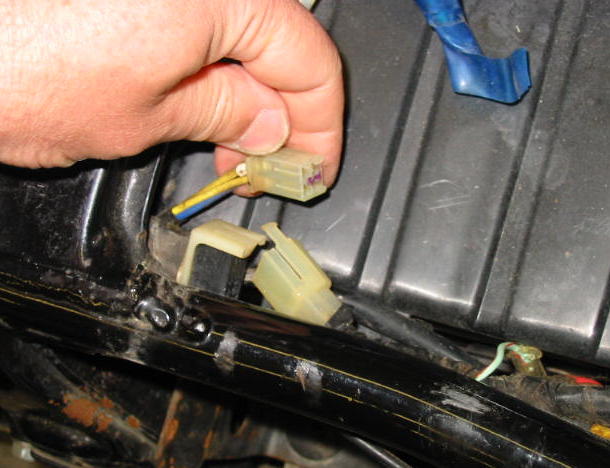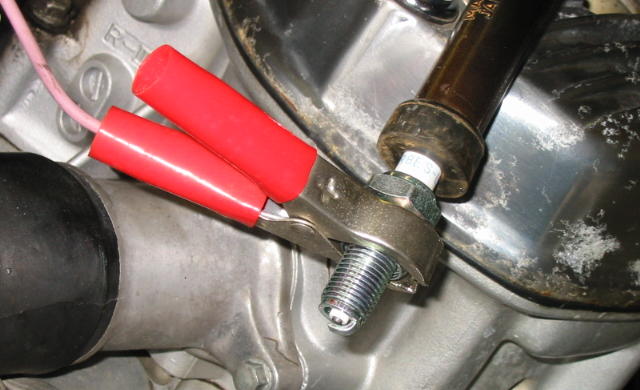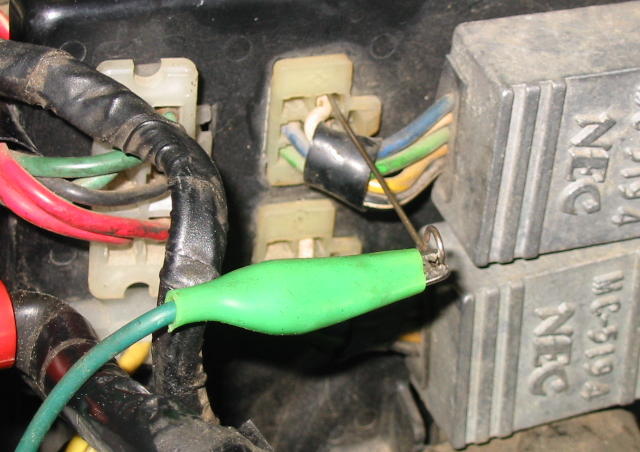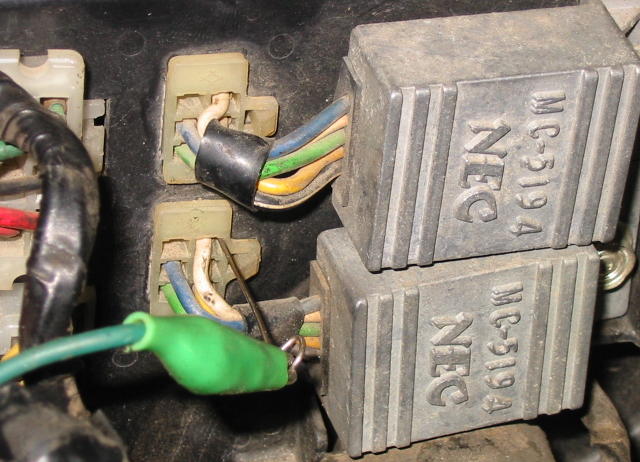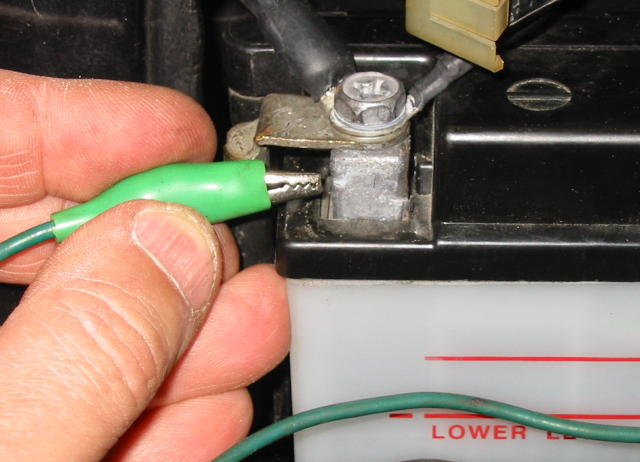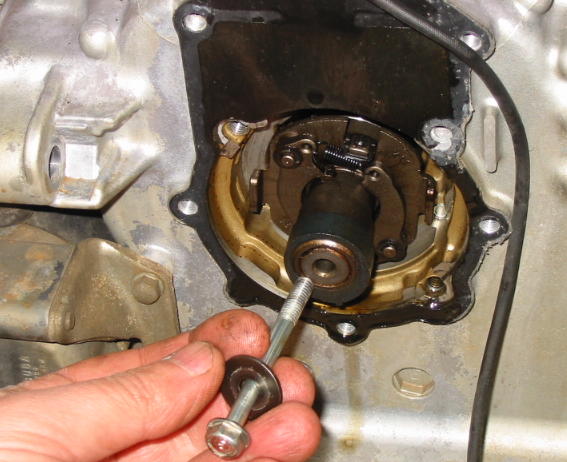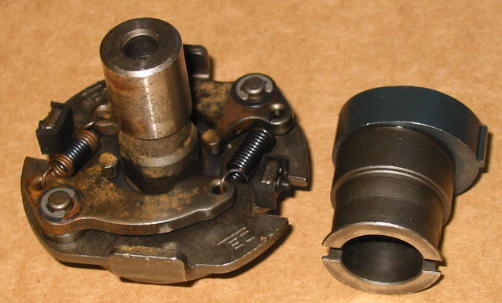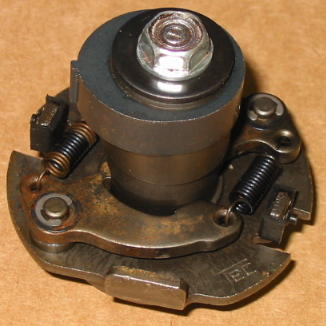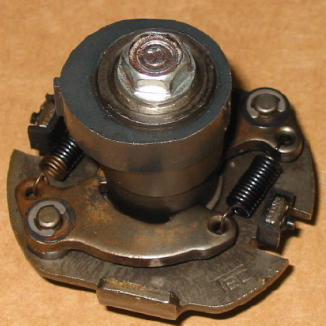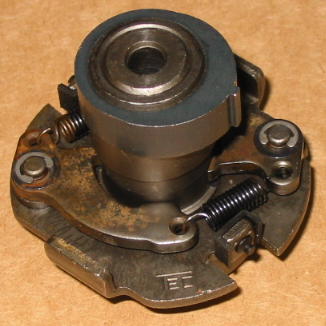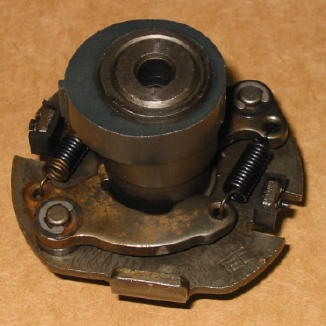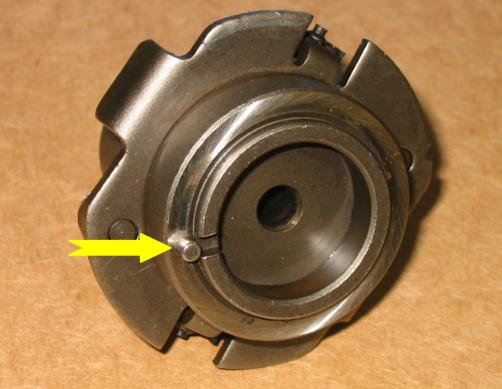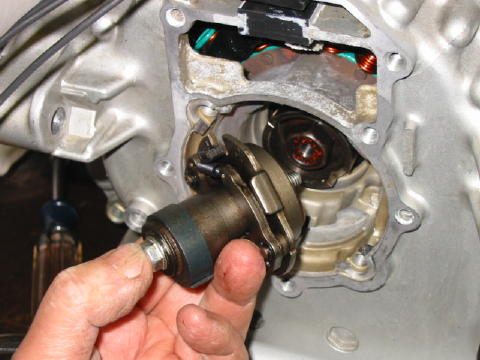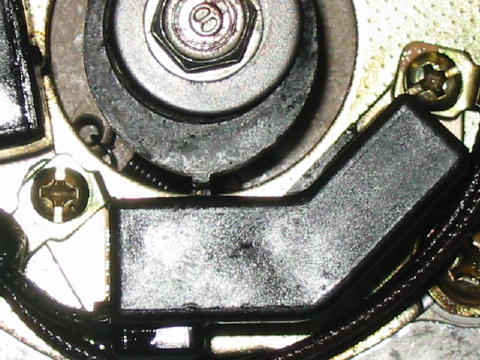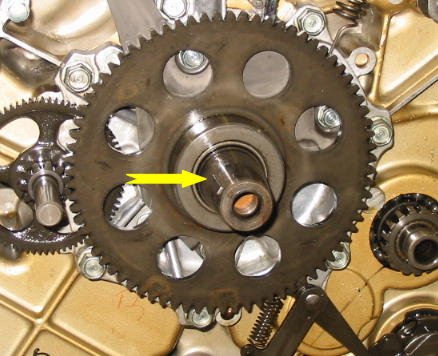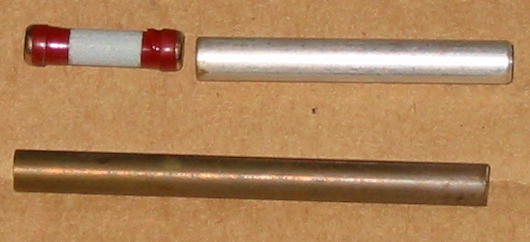Old Ignition Page
Contents
- 1 Ignition system - FADM Stern GNSF & Dave F.
- 2 Here is another detailed discussion of the ignition system by Dave F. Thank you, Dave.
- 3 Ignition Problems
- 3.1 Before you slide that rear cover back on, do this quick check of the pulsar coils. If they are reversed, the bike won't run, or run very poorly. He is a post from MurryF explaining how to check:
- 3.2 #WHOA--If you have the stator and pickups unbolted from the back cover, it is possible to reverse the way the pickups are bolted into the back cover and it goes like this (LOL) the pickups are marked R & L BUT THIS IS WHEN FACING THE FRONT OF THE BIKE so in other words when the cover is installed. When you remove the rear cover they look backwards just like the picture, BECAUSE YOUR ARE FACING THE BACK OF THE BIKE I have seen many times when people get their stators back from Gary or when they have had the motor apart, they forget how they came out, so they install the right on the right and the left on the left SO THEY NOW HAVE THEM BACKWARDS.If you have the stator and pickups unbolted from the back cover, it is possible to reverse the way the pickups are bolted into the back cover and it goes like this (LOL) the pickups are marked R & L || http://cx500forum.com/forum/attachments/technical-help-forum/8255d1392657238-spark-fuel-still-no-flame-help-me-somebody-l-r.jpg%7Cthumb%7C647x366px%7CName: L&R.jpg || || Name: L&R.jpg Views: 0 Size: 1.67 MB || BUT THIS IS WHEN FACING THE FRONT OF THE BIKE so in other words when the cover is installed. When you remove the rear cover they look backwards just like the picture, BECAUSE YOUR ARE FACING THE BACK OF THE BIKE I have seen many times when people get their stators back from Gary or when they have had the motor apart, they forget how they came out, so they install the right on the right and the left on the left SO THEY NOW HAVE THEM BACKWARDS.
- 3.3 Caps are also available new
Ignition system - FADM Stern GNSF & Dave F.
The ignition system can be a source of much grief to the bike owner, as there seems to be so many things that can fail and cause all sorts of problems. While it is true this system can fail in several ways and show a variety of symptoms, once a basic understanding of its operation is understood, troubleshooting gets a whole lot easier.
- Ignition System
The ignition system on these bikes controls the firing of the spark plugs based on the Engines speed. The main components of the ignition system are;
- Stator High Voltage Coils (ONLY if it is a CDI bike)
- Advancer Coils (2 sets in the CDI system)
- Spark Control Unit (CDI [Capacitive Discharge Ignition] module OR TI [Transistorized Ignition] modules (2) )
- Ignition coils
- Spark Plugs, Wires and Caps
#StatorStator (CDI ONLY)
On CDI bikes, there are two coils that are part of the bikes stator, but are not involved in the charging circuit, and are used to supply voltage to power the CDI unit.
- Problems
If the high voltage coil on the stator fails, it can cause major problems with the bike entire ignition system. If the coil fails completely (open circuit) the bike will not run or start at all, as there is no power for the CDI unit to generate an ignition pulse. If the coil partially fails (short of coil winding to ground), the supplied power will be too small for a good ignition pulse and the bike will either not run, or run very poor (missing and sputtering).
#AdvancerAdvancer coils
These coils are used to advance the timing on the spark plugs, making them fire a bit sooner. The reason for this is that it takes a "specific amount" of time from the moment a spark is sent to the spark plug until the fuel fully combusts. For this reason, the spark plugs in an engine are fired a little before the piston reaches TDC (Top Dead Center), so that by the time the piston is at the top (full compression) the spark has had the needed time to ignite the air-fuel mixture. This is done by a set of coils mounted on the rear case called Advance Coils (or Advance Pulsars). These coils pick up a signal from a rotating "hub" on the crank shaft that spins past these coils each revolution. These coils are set up to send a pulse to the "spark control system" when it is time to send a spark to that cylinder (this is why there are TWO pulsars, one for each cylinder). Timing of these pulses is set to a "desired point" measured in "degrees of rotation before top dead center", which results in a "spark signal" being sent "in advance" of the piston, i.e. Advance coils.
Now this is great at idle, BUT as the engine RPM increases, so does the crank shaft rotation, which means the piston takes LESS TIME to get to TDC from the advance mark than at idle. This means that if the coils were fixed, as the speed increased the timing would get worse, so a method of "varying the timing of the pulse with engine speed" must be used.
- Advancer Coils (CDI)
In the CDI system there are two sets of advance pulsar coils. Once set is located in the rear of the engine near the stator (Fixed Pulsars), and one set is located in a housing on the rear of the engine (Advance pulsars). These pulsar sets are fed to the CDI unit, which uses signals from both sets to set the spark timing. The actual operation is complex, but simplified it works as follows. The fixed pulsars are used to provide timing when the engine is at idle, but as the RPM increases the signals from the advanced pulsars start to mesh with the fixed pulsar signals and skew the timing a bit. The more the engine speed increases, the more the timing pulse gets "skewed". The CDI then uses this signal to fire the ignition coils. Since all pulsars in this system remain in a "fixed' location, timing on these engines cannot be adjusted.
- Problems
If the advancer coils fail, it will affect the operation of the engine. If the fixed pulsars fail, the bike may start but will idle very poorly, but may improve as the RPM is increased. Similarly, if the advance pulsars fail, the engine will idle ok, but experience sever loss of power at higher RPMS, which would be limited to about 5,000 RPM (will not go higher).
- Advancer Coils (TI)
The advance coils on the TI system use a centrifugal mechanical mechanism to advance the position of the "rotating hob" that triggers the coils. As engine speed increases, the increase of centrifugal force on a plate and spring assembly "advance" the triggering hub on the crank shaft, thereby keeping the signal point at the desired DBTDC (Degrees Before Top Dead Center). Since this mechanical advance unit plate can be slightly rotated, this engine can have the timing adjusted and set by changes in the plate’s position.
- Problems
A failure of the Advancer coils in a TI system will cause the bike to simply not want to start or run. If the coils are intact but grounded, the bike may run, but not smoothly, with it missing at all RPMs.
#SCUSpark Control Unit (CDI)
The CDI (or Capacitive Discharge Ignition) unit functions by the discharge of a capacitor into the ignition coil to produce the high voltage pike that is sent to the spark plug. The unit contains a capacitor that is charged up by voltage generated from the high voltage coils on the stator. Once the CDI receives the timing signal, it discharges the capacitor into the ignition coil, generating a very high voltage spike that jumps the gap in the spark plug, causing the spark. Since the CDI receives this charging power from the stator HV coils, failure of these coils will prevent the bike from running.
Here is a link on building Your Own CDI
- Problems
A failure of the CDI unit can affect the operation of the engine, from a simple ignition miss every so often, to a complete inoperable engine. Depending on what part has failed in the CDI, different symptoms can surface such as;
- Loss of high end RPM
- Sporadic ignition
- Loss of function of one or more cylinder
- RPM fluctuation
- Misfires (backfires)
- Loss of power
- Spark Control Unit (TI)
The TI (Transistorized Ignition) is a far superior and more reliable method of generating ignition sparks, as it does not rely on charged capacitors (which do degrade over time). In this system, power for the unit is supplied by the bikes power buss (battery), and once a timing signal is received from the pulsar coils, a transistor is used to send a pulse to the ignition coils.
- Problems
The failure of the TI control will result in that cylinder not firing. This makes these a bit easier to troubleshoot, as when they fail they just don’t work.
#CoilsIgnition Coils
The ignition coils on the bike are "common coil" (meaning one leg of both the primary and secondary coils is grounded) step up transformers. They function by taking the voltage applied to the primary coil and inducing a much large voltage (in the range of Tens of thousands of volts) in the secondary coil (step up). The voltage amplified is in the form of a very narrow "spike", which when amplified in the secondary is sufficient to jump a small air gap in the form of a spark. This is what is passed to the spark plug via the plug wire and cap.
3 ohm coils are what GL500s and all 650s use. Transistorized Honda ignition uses 3 ohm coils.
Charles.
The CX's use 7,500 ohm coils with the CDI ignition. This means you will measure 7,500 ohms across the secondary of the coil. Note that to measure this 7,500 you need to do one of two things One unscrew the spark plug connector from the wire. OR
use a screwdriver inside of the spark plug cap and unscrew the resistor holder. the resistor and a spring will then drop out.
Be sure the resistor is good.
The primary measures one ohm.
Arydberg
- Problems
When an ignition coil starts to fail it can produce a week spark or simply fail completely.
- Spark Plugs
Spark plugs are simply a high tech "air gap" of a specific size to allow the spark to jump across the gap and ignite the air/fuel mixture in the cylinder. It should be noted that the spark plug leads and cap play an important role with that of the spark plug. The spark plug itself is designed to provide a hot spark, but also to quickly remove this heat as well as establish an air tight seal for combustion. The spark plugs themselves are a great "window" to the operation within the engine, and by checking the color and state of the electrodes, a wealth of information can be determined about the performance of the combustion phase itself. All spark plugs are NOT created equal, and some important differences in plugs are temperature rating, electrode depth and voltage range. You must make sure that the proper plug is used with these engines to ensure reliable operation and to prevent damage.
- Problems
The main problem that occurs with spark plugs is the "foul up" where "gunk" can partially block the spark gap resulting in a weak spark. If the fouling is bad, it can act to electrically "bridge" the gap resulting in no spark at all. Also, some times the insulation cracks which can cause the spark to be generated at another location within the plug. If a plug is running to hot, "detonation" or melting of the base electrode can increase the gap size past the point a spark can jump. Problems with the spark plug lead and cap can also cause ignition problems. since the ignition "spike" is a very high voltage, and insulation cracks and gaps can allow some of this energy to "bleed off" before it reaches the spark plug. Corrosion in the spark plug cap can also cause bad connection issues.
Here is another detailed discussion of the ignition system by Dave F. Thank you, Dave.
Ignition Problems
Two major types of ignition systems were used on the CX and GL bikes, the CDI (capacitive discharge ignition) and the TI (or TAI, transistorized ignition). CDI's were used on CX models through 1981. Starting in 1982, CX bikes used the TI. All GL models used the TI. Of the two types, the TI is much more reliable in addition to having other advantages. The above information is specific to US models. There may be variations for other countries.
- TI Systems
- Introduction
The TI system is extremely reliable. Its major components include two ignition modules, the ignition switch, the kill switch, a timing pickup coil assembly located at the rear of the crankshaft, and two ignition coils/plug wires/spark plugs. The two grey-colored ignition modules are shown in this photo.
The left and right side ignition systems are almost completely independent. The only circuits they share are power and ground. Due to the simplicity of this system, there is not much to check. To troubleshoot a TI ignition system, proceed as follows.
- Power and Ground Tests
Set the multimeter to measure DC Volts. The negative meter lead should be connected to the negative battery terminal. Turn the ignition switch to the on position. Measure the voltage on the positive battery terminal. If it is not at least 11 Volts the battery is likely discharged or defective, and this should be corrected before proceeding further. The TI ignition system cannot operate reliably with insufficient battery voltage or with the battery disconnected. (Never try to operate the bike without a battery installed!) Measure the voltage on the green wire at either of the ignition module connectors. The green wire is the wiring harness ground. If the green wire reads more than a few tenths of a Volt then there is a ground problem with the wire harness. Refer to the main fuse and grounding page. Next, measure the voltage on the black/white wire at either of the ignition module connectors. This is the power feed to the ignition modules. If the voltage here is not approximately the same as the battery voltage, the likely culprit is the kill switch or the ignition switch or the main fuse. With the multimeter settings and negative meter lead unchanged, you can now probe these items to see where the power is being lost. Repeat the measurements while cranking the engine. If the readings in this section are all good there is no problem with the power being applied to the ignition system; the battery, kill switch, ignition switch, and associated wiring are not the problem.
- Ignition Pickup Simulation Test
Once the power and grounds have been verified to be good, the test described in this section should be performed to determine if the problem is related to the ignition pickup circuit or elsewhere. First, unplug the ignition pickup coil connector.
Remove the spark plug on the side that has the problem. Insert the plug into the plug cap and ground the plug body. In this photo, the other end of the test lead is connected to a ground lug on the frame. Do not use the valve covers for a ground as they are insulated by rubber. Position the plug so the gap can be easily seen.
Next, probe the white wire connector pin of the ignition module associated with spark plug under test. A short piece of welding wire works well for this. Use a test lead or wire to make this connection.
Which module is associated with a particular spark plug? It's not safe to assume one because someone may have previously swapped the wiring harness connectors behind the panel. Accordingly, it's best to repeat this test using each module. Set the ignition switch to the on position and repeatedly touch the other end of the test lead to the negative battery terminal.
A spark should be created every time the test ground connection is broken. This test simulates a pulse from the ignition timing pickup coils. If a spark is created, the problem is due to the ignition timing pick up coils or the mechanical timing advance unit, both located on the rear of the engine under the timing cover. If a spark was not created, the problem is due to something else. Unfortunately, it is necessary to pull or move the engine forward to provide the clearance needed to remove the timing cover should that be necessary.
- Timing Pickup Coil Resistance Tests
The timing pickup coils can be tested without removing the engine. There are two coils, one for each side, and they share a four pin connector located under the rider's seat:
Unplug the timing pickup coil connector to make the resistance measurements. Make measurements on the end of the cable that goes to the engine, not the ignition units. The end to measure is the one being held in the above photo. The resistance between the two yellow wires should measure 530 Ohms. The resistance between the two blue wires should measure 530 Ohms. If the measured values are within ten percent of 530 Ohms that is acceptable. Also measure the resistance between these wires and ground. The measured value should be infinity, or an open circuit. If the pickup coil resistances check out ok, it is fairly certain the pickup coils are not faulted.
- Ignition Timing and the Mechanical Advance Timing Unit (ATU)
In this section, some of the common ignition timing and associated mechanical advance timing unit problems are discussed. The ignition timing is set during engine assembly and is not a routine maintenance action. The GL factory service manual details the static timing adjustment procedure and should be carefully followed whenever the engine is reassembled. The mechanical advance timing unit is shown in this photo. It is mounted to the rear of the crankshaft flywheel/rotor.
The mechanical advance timing unit is held in place with the bolt and washer as shown above. Mistakes commonly made during engine reassembly are not using the washer or not torquing the bolt to spec using a torque wrench. If the bolt is not torqued to spec it can work loose after the engine has been running for a while. Similar problems can result if the washer is omitted, as described below. The mechanical advance timing unit consists of two major subassemblies:
Note the washer diameter is significantly larger than the bolt head:
If the washer is omitted, or a smaller washer is used, the end of the mechanism is only partially covered:
If assembled in this condition, the mechanism can come apart after the engine has been running for some time:
When this happens, the symptom is no spark on either side. This illustrates the importance of using the correct washer during reassembly, and torquing the bolt to spec. The mechanism can also come apart during handling. There are two ways it can be reassembled. One way is correct, and the other way will result in the timing being out by 180 degrees:
Which way is correct? My preference is to simply assume one and make absolutely certain the static ignition timing checks described in the factory service manual are performed. If the wrong way was chosen, the error will be detected at that point while it is still easy to correct. The worst thing to do is simply reassemble the engine and skip the static timing checks - more than one person has had to pull the engine to change the assembly orientation after guessing wrong. Feeling lucky? This is the rear of the mechanical advance timing unit. Note locating pin:
There are two slots that this pin can fit into on the flywheel/rotor, a wide slot and a narrow slot. It should be inserted in the narrow slot:
The factory service manual procedure calls for the pickup coil static timing to be adjusted and then checked twice, once when the crankshaft is set to "FS" on the left side and once when set to "FS" on the right side. When this is done, the nub on the rotor should align with the nub on the applicable pickup coil. If the mechanical advance timing unit is assembled or installed incorrectly the static timing will not even be close.
This may all sound confusing but it's really very simple and fast to check the proper orientation. One of the forum members on the Honda CX500 and GL500 Forum, fastpakr, summed it up with these words: "To test that the rotor's properly installed on the timing advance mechanism, just rotate the crank until the FS||FI marks are visible through the inspection port. If the rotor is pointing at one of the pulse generators, you're all set. If not, remove the rotor and reinstall it 180 degrees off. Verify that it's now pointing at an advance unit and you're all set." As mentioned above, the mechanical advance timing unit is mounted to the rear of the crankshaft flywheel/rotor. Thus, if the flywheel is not in the proper position the timing will not be correct. The flywheel is held in the proper position by a woodruff key on the crankshaft:
The timing may be off if this key was omitted during engine reassembly. There have also been rare instances where this key has been sheared in half.
Here is something else to keep in mind if you are replacing the stator:
Before you slide that rear cover back on, do this quick check of the pulsar coils. If they are reversed, the bike won't run, or run very poorly. He is a post from MurryF explaining how to check:
#WHOA--If you have the stator and pickups unbolted from the back cover, it is possible to reverse the way the pickups are bolted into the back cover and it goes like this (LOL) the pickups are marked R & L BUT THIS IS WHEN FACING THE FRONT OF THE BIKE so in other words when the cover is installed. When you remove the rear cover they look backwards just like the picture, BECAUSE YOUR ARE FACING THE BACK OF THE BIKE I have seen many times when people get their stators back from Gary or when they have had the motor apart, they forget how they came out, so they install the right on the right and the left on the left SO THEY NOW HAVE THEM BACKWARDS.If you have the stator and pickups unbolted from the back cover, it is possible to reverse the way the pickups are bolted into the back cover and it goes like this (LOL) the pickups are marked R & L || http://cx500forum.com/forum/attachments/technical-help-forum/8255d1392657238-spark-fuel-still-no-flame-help-me-somebody-l-r.jpg%7Cthumb%7C647x366px%7CName: L&R.jpg || || Name: L&R.jpg Views: 0 Size: 1.67 MB || BUT THIS IS WHEN FACING THE FRONT OF THE BIKE so in other words when the cover is installed. When you remove the rear cover they look backwards just like the picture, BECAUSE YOUR ARE FACING THE BACK OF THE BIKE I have seen many times when people get their stators back from Gary or when they have had the motor apart, they forget how they came out, so they install the right on the right and the left on the left SO THEY NOW HAVE THEM BACKWARDS.
- CDI Systems
The CDI system is completely powered from the stator and is electrically isolated from the rest of the bike's electrical system. Its major components include the stator, the CDI unit, the ignition switch, the kill switch, two pickup coils, and two ignition coils/plug wires/spark plugs. Since the system is completely powered from the stator, if the engine turns over too slowly there will be insufficient electrical power generated in the stator to support ignition. Therefore the ignition system could appear to be malfunctioning when in reality the problem is nothing more than a weak battery. If the engine does not turn over fast it would be worth jumping the battery to see if the bike starts - see the comments on jump starting on the battery charging page. The CDI unit has a black wire with white stripe attached to an inline bullet connector. This wire is an input to the CDI unit, and its purpose is to turn off the ignition. Grounding this wire will kill the ignition. If this connector is unplugged, the bike will continue to run even if the ignition switch is set to off and the kill switch is engaged. Similarly, if there is a short to ground on this wire then the ignition will not operate. The inline bullet connector can be used for troubleshooting. If the bike will not start, unplug the bullet connector and try again. If it starts this time, the problem is likely either the kill switch, the ignition switch, or the associated wiring. Troubleshooting techniques associated with finding a short to ground can then be used to isolate the problem. CDI unit failures and stator failures are both fairly common. Unfortunately, the CDI unit cannot be tested with a multimeter so the process of determining if a CDI unit is bad comes down to swapping it out with a known good unit. Although the CDI system is electrically isolated from the rest of the bike's electrical system, it does share the same stator. Even though the stator CDI windings are electrically isolated from the charging windings, they are linked together magnetically. Consequently, a shorted charging winding can impact ignition system operation. On occasion, unplugging the stator charging connector (the one with three yellow wires) will allow the bike to be started when it could not be started otherwise. If this happens, it is virtually certain that the stator has a shorted winding and needs to be replaced. Resistance checks can be performed on the stator with limited success. If a stator resistance measurement is grossly out of spec then the stator is virtually certain to be defective. However, if the resistance measurements are within 10 percent or so of spec limits the stator may or may not be bad. To complicate matters further, the resistance measurements could all be well within spec and the stator could still be bad. The resistance checks are outlined in the Honda factory service manual. A pdf copy can be downloaded for free from here. The CDI stator has two windings dedicated to powering the CDI system, and the remaining windings are used by the charging system. In contrast, all of the TI stator windings are used by the charging system. Consequently, the TI stator has significantly more electrical output power for charging the battery and powering accessories such as heated clothing or auxiliary lighting. An aftermarket replacement CDI unit has recently become available from Ignitech in the Czech Republic and has been getting great reviews. The Ignitech unit obtains its power from the bike's 12 Volt electrical system, not the stator, thus allowing the TI stator to be installed in place of the CDI stator. If you are considering an upgrade to this unit, it would be worth checking out the Honda CX500 and GL500 forum to see if a discount group purchase is currently being made. Ignition Coils Ignition coils have been known to fail on occasion, but they are generally pretty reliable. The most dependable method of testing a suspect ignition coil is to swap it out with another one. The left and right side coils are electrically identical, so if it has been determined that one side of the bike is not firing then the coils can be swapped to see if the problem follows the coil or stays on the same side. #PlugsPlugs, Wires, and Caps Problems with spark plug wires and spark plug caps are not uncommon. Plug cap problems usually show up as an open circuit and are often intermittent. In some cases, the internal resistor fails. This resistor is a holdover from the days when AM radio was prevalent. Its purpose was to reduce AM radio interference. A popular modification is to replace the resistor and its adjacent aluminum spacer with a piece of brass rod stock cut to length.
A plug cap problem was recently diagnosed on a GL650. The bike would start up and idle fine for about twenty minutes and then it would stumble and die. After it had cooled down, it could be started again and the cycle would repeat. The problem was isolated over a period of time by methodically swapping parts until it went away. A multimeter resistance reading showed that the plug cap had an open circuit. It was then cut open with a Dremel tool for inspection. The top contact within the cap had significant corrosion and some sort of greyish-black build-up on it. Plug wire problems are usually associated with a breakdown in insulation, resulting in arcing. Start the engine when it is completely dark and look along the wire for evidence of arcing. You can also run a small neon test bulb alongside the wire to see if it fires. A hand can also be used, but it will be more painful when an insulation breakdown is found.
- Spark Plugs
Defective brand new spark plugs due to manufacturing errors are sometimes encountered. In one instance the center electrode inside the plug was completely missing. If an ignition problem arose during maintenance when the plugs were replaced, try re-installing the old ones. If one new plug is defective there is a good chance the other one is also bad, particularly if both plugs came from the same production lot.
- Iridium plugs
Some people have reported not all parts stores can find a cross reference for Iridium plugs. Below is what some of the forum users have reported working well for their applications.
- NGK DR8EIX AKA NGK 6681 Resistor plugs have been reported to work well both with stock carbs, ignitech and resistor caps, as well as a Murray Carb Kit
- Parts Interchangeability
Few if any parts can be interchanged between the TI and CDI systems. The ignition coils are incompatible. The kill switches are also different - the TI kill switch creates an open circuit to stop the ignition, whereas the CDI kill switch creates a short circuit to perform the same function.
- Problems When It Rains
Honda CX500 and GL500 Forum member Yooper Ken posted this information, reproduced here with permission:
"The problem was whenever it rained my bike would simply not run as good and go as far as to run downright crappy. But as soon as the rain quit the problem was gone. I even blasted it with a garden hose and couldn't replicate the problem.
After disassembling everything electrical I could think of, I was down to the coils. On the 82cx and others, the coil wires can be removed by unscrewing a plastic cap on the wire. There is a compression seal around the wire under the cap. Apparently mine didn't seal well enough. I trimmed an 8th inch off the wires, cleaned the terminals on the coil, and put a nice bead of silicone around the rubber seal. After tightening the caps/wires back on to the coils and cleaned up the excess silicone that oozed out....that was it.
I now can have ridden in the hardest down pours without issue."
Thank you for sharing this, Ken.
Caps are also available new
The no resistor type from Wemoto,
http://www.wemoto.co...cx_500_a/79-80/
David Silvers are good as well and both post international.
There are also some available on ebay
You can also get a new NGK straight cap with resistor.
This site is backed by Number 85, who provide the hosting. If you need a website done, get in touch with them.
